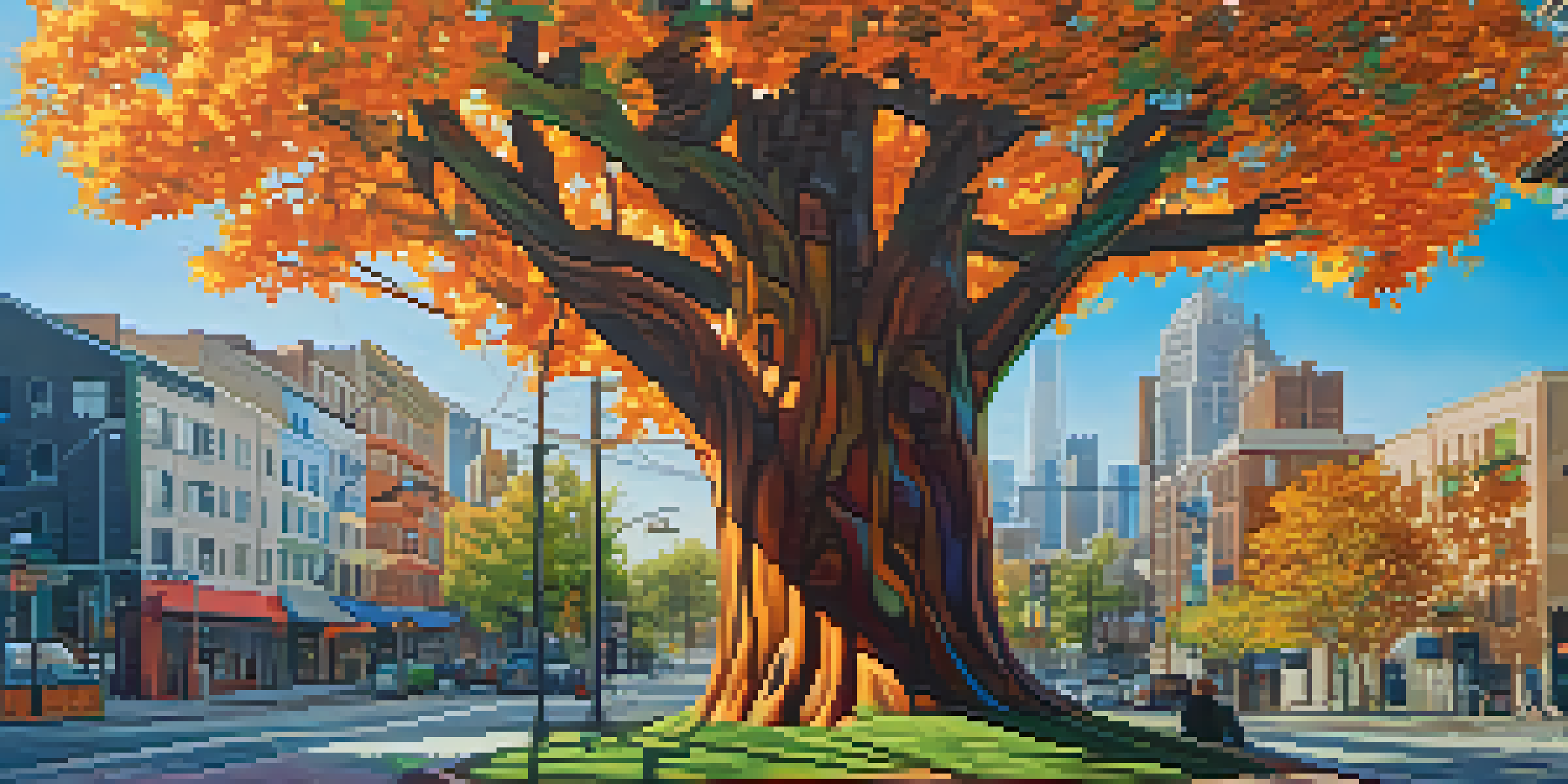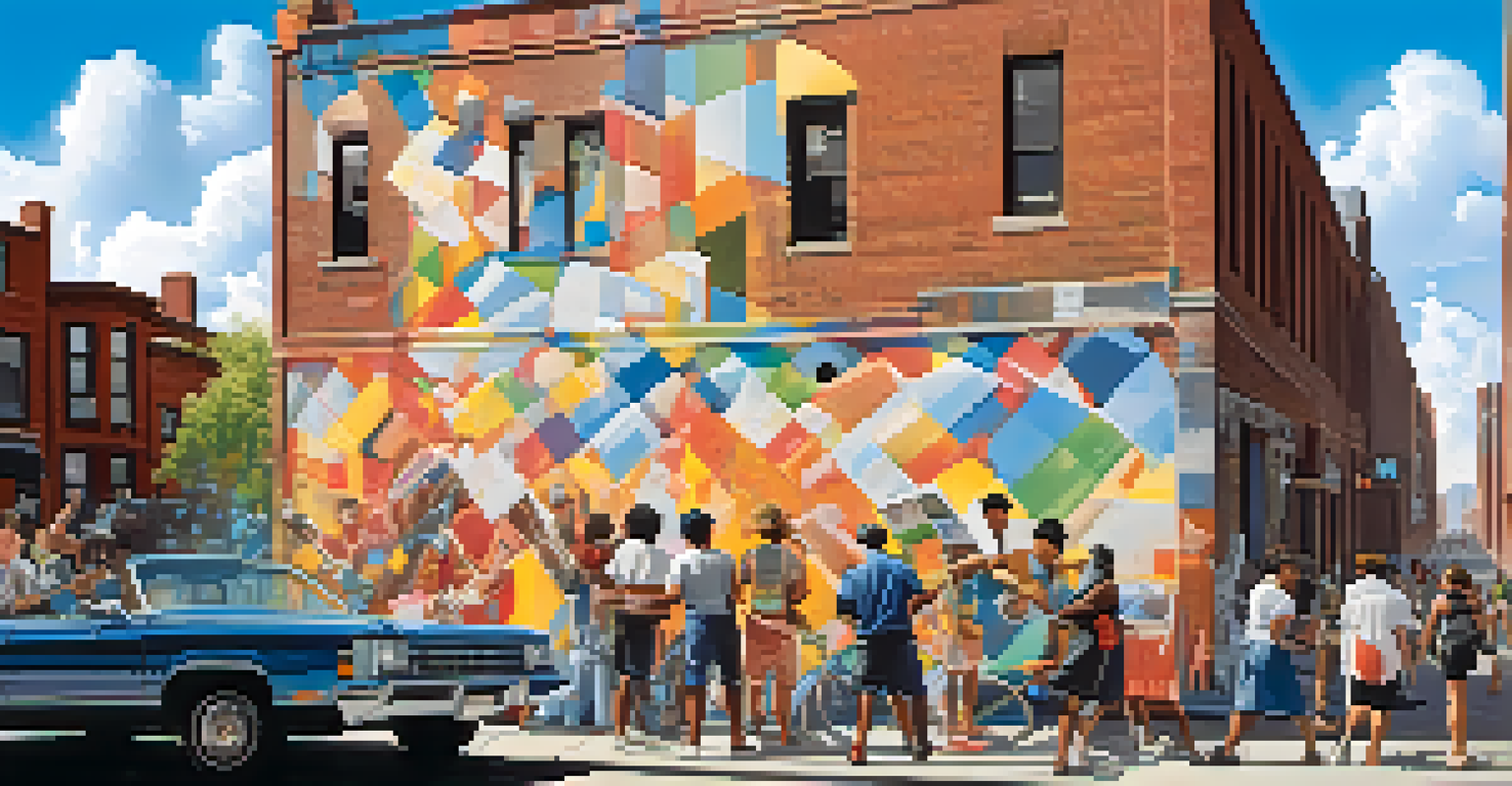Exploring Street Art: Urban Culture in Major Cities

What is Street Art? A Brief Introduction
Street art encompasses a variety of visual art forms created in public spaces. Unlike traditional art, which is often confined to galleries, street art bursts into cities, transforming ordinary walls into canvases of expression. It includes graffiti, murals, and installations, each telling unique stories about the neighborhoods they inhabit.
Art is not a mirror to reflect reality, but a hammer with which to shape it.
Often seen as a form of rebellion, street art challenges societal norms and gives voice to the marginalized. For instance, a mural in a bustling urban area might highlight social issues or celebrate community pride. This accessibility allows everyone, regardless of background, to engage with the art, making it a powerful tool for dialogue.
Moreover, street art serves as a reflection of contemporary culture, adapting to the city's pulse. In this way, it not only beautifies urban spaces but also fosters a sense of identity and belonging among residents. As cities evolve, so does their street art, making it a dynamic snapshot of urban life.
The Cultural Significance of Street Art
Street art is more than just aesthetics; it's a cultural phenomenon that captures the spirit of a community. Artists use their work to comment on social, political, and environmental issues, making it a medium for activism. From Banksy's satirical pieces in London to the powerful murals in Mexico City, street art serves as a visual commentary on the world around us.

In many cases, street art revitalizes neighborhoods, drawing tourists and locals alike. For example, the Wynwood Walls in Miami transformed a neglected area into a thriving arts district, showcasing large-scale murals from renowned artists. This not only boosts the local economy but also fosters community pride and engagement.
Street Art as Cultural Commentary
Street art serves as a powerful medium for artists to comment on social, political, and environmental issues, reflecting the spirit of their communities.
Additionally, street art often bridges cultural gaps by incorporating diverse artistic influences. This melting pot of styles reflects the multicultural tapestry of urban life, making it relatable to a wide audience. As such, street art becomes a celebration of diversity, inviting everyone to explore and appreciate different perspectives.
Iconic Cities Known for Their Street Art
When it comes to street art, certain cities stand out as global hotspots. Berlin, for instance, is famous for its vibrant murals and graffiti that tell stories of its tumultuous history. The city has embraced street art as a form of expression, allowing artists to transform the urban landscape into a living gallery.
The street is the only place where the true and the false can be reconciled.
Similarly, Melbourne is renowned for its laneways adorned with ever-changing murals that reflect both local and international influences. The city's commitment to street art is evident in events like the Melbourne International Street Art Festival, which celebrates creativity and encourages local talent. This dynamic environment makes the city a playground for artists and art lovers alike.
New York City, often considered the birthplace of modern graffiti, boasts iconic pieces that have become landmarks themselves. From the hauntingly beautiful murals in Bushwick to the vibrant street art of the Lower East Side, NYC offers a rich tapestry of artistic expression. Each neighborhood has its own flavor, making street art an integral part of the city's identity.
Street Art as a Form of Political Expression
Street art has long been a powerful medium for political expression, allowing artists to voice dissent and challenge authority. In many cases, murals and graffiti serve as a form of protest, bringing attention to social injustices and political issues. For example, during the Arab Spring, street art became a significant tool for activists to convey their messages and inspire change.
Artists often use imagery and symbolism to provoke thought and encourage dialogue about pressing issues. In places like Venezuela, murals depicting the struggles of everyday citizens can be seen throughout the streets, highlighting the impact of political turmoil. This ability to convey complex messages in a visually striking way makes street art a unique form of communication.
Cities Embrace Street Art Evolution
Urban areas are increasingly recognizing street art as a legitimate form of expression, leading to commissioned murals that enhance community identity and tourism.
Moreover, the ephemeral nature of street art adds to its potency. Many pieces are short-lived, either painted over or removed, which creates a sense of urgency around their messages. This transience encourages viewers to engage with the art before it's gone, making each piece a fleeting yet impactful commentary on society.
The Evolution of Street Art: From Graffiti to Muralism
Street art has evolved significantly over the decades, transitioning from underground graffiti to widely accepted muralism. Initially, graffiti was seen as vandalism, often resulting in legal consequences for artists. However, as appreciation for this art form grew, cities began to recognize its potential to beautify and energize urban spaces.
Today, many municipalities actively commission street artists to create large-scale murals that enhance public areas. This shift reflects a growing recognition of street art as a legitimate form of artistic expression, capable of contributing to community identity and tourism. Artists like Shepard Fairey have gained international acclaim, further blurring the lines between street art and mainstream art.
Additionally, the rise of social media has played a crucial role in this evolution. Platforms like Instagram allow artists to showcase their work to a global audience, fostering connections and collaborations across borders. As a result, street art continuously evolves, influenced by both local culture and global trends.
Street Art Festivals: Celebrating Creativity and Community
Street art festivals have become a vibrant celebration of creativity, drawing artists and enthusiasts from around the world. These events often feature live painting, workshops, and exhibitions, creating a dynamic atmosphere that fosters collaboration and connection. Festivals like the Upfest in Bristol and Pow! Wow! in Hawaii highlight the diversity of street art while supporting local artists.
These festivals offer a platform for emerging talent, allowing them to showcase their work alongside established artists. By bringing together different styles and perspectives, they create a rich tapestry of expression that reflects the community's character. Attendees not only witness the creation of stunning artworks but also engage in conversations about the culture and issues that inspire the artists.
Festivals Celebrate Artistic Diversity
Street art festivals foster collaboration among artists and create lasting community impact by transforming public spaces into vibrant open-air galleries.
Moreover, street art festivals often have a lasting impact on the communities where they take place. Once the event concludes, the murals remain, transforming public spaces into open-air galleries. This not only beautifies neighborhoods but also encourages local pride and tourism, making these festivals a win-win for everyone involved.
The Future of Street Art: Trends and Innovations
As urban landscapes continue to evolve, so does the world of street art. New trends and technologies are shaping how artists create and share their work. For instance, augmented reality (AR) is becoming a popular tool, allowing viewers to engage with street art in interactive ways. This fusion of technology and art opens up exciting possibilities for creative expression.
Additionally, the focus on sustainability is influencing street art practices. Many artists are now using eco-friendly materials and techniques, highlighting environmental issues through their work. This shift not only promotes responsible art-making but also encourages conversations about sustainability in urban spaces.

Furthermore, the global pandemic has prompted artists to adapt their messages and methods. Many have turned to themes of hope and resilience, reflecting the challenges faced by communities. As street art continues to respond to societal changes, it remains a vital part of urban culture, evolving alongside the cities it adorns.